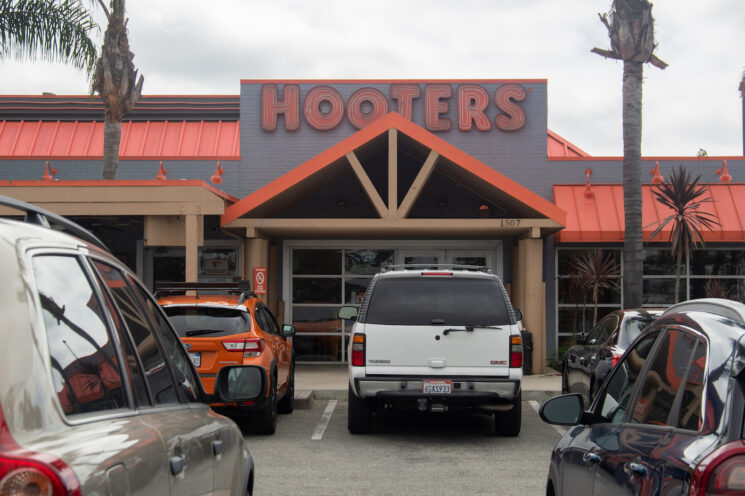
By Rebecca Do
As time passes, it changes our food and in turn, changes our dining establishments. Restaurants in America have been shaped by history, economic struggle and triumph and cultural diversity. From colonial taverns of the 18th century to iconic New York steakhouses, the American dining experience remains diverse—unparalleled but wavering.
One day, that dining experience was elevated by well-endowed women in short shorts and low-cut tops. The rise of the “breastaurant,” as it is so aptly nicknamed, stemmed from the establishment of the first “Hooters.”
“Hooters,” established in 1983, describes their beginnings as when “six businessmen with no restaurant experience whatsoever got together to open a place they couldn’t get kicked out of.” Immediately, that sentence sets off alarm bells in my head. Why would these men get kicked out of said places? What exactly did they do?
But I digress. Just reading the history of the establishment reveals that the restaurant had suspicious beginnings. Though there’s no explicit proof that there was any malicious or exploitative intent in the process of making the restaurant, I think it’s safe to say that the uniforms and advertisements speak for themselves.

Again, though founded with no explicit intention of exploiting women, the entire business model of these so-called “breastaurants” is sexist and exploitative, though I support the waitresses in their decision to keep working at this establishment.
But I do not want to make an unfounded claim without having lived the experience! What is a journalist to do?
The answer is simple: eat at Hooters.
Entering the restaurant was definitely an interesting experience. Baseball and basketball were on the big screen, the lights were dimmed. The wooden, rustic interior with country music blasting made for quite the unsettling ambience as a 9/11 poster and flyers advertising March Madness deals bore into the souls of me and my photographer.
Between the two of us, we ordered the 15-piece buffalo wings, a Cali burger and a side of waffle fries. As our waitress approached us, I froze. There was nothing worse than going to a restaurant where you were forced to be surrounded by attractive people, but she was incredibly kind to us as she took our order. The service was impeccable and she checked on us a total of four times throughout the meal.
Two families, each with what we presume a wife and kids came into the restaurant at the same time we did; A family-friendly establishment indeed. Another noticeable surprise was the fact that two children, seemingly under the age of 16, were in the restaurant by themselves. There was nothing inherently wrong with that—it was just odd.
The rest of our dining experience ran smoothly as dishes, wet wipes and chicken bones piled up. She checked on us one last time, we paid the check and left the fine establishment, never to come back again.
Reflecting on my Hooter’s experience led me down a rabbit hole; what truly, does being a “Hooters Girl” entail? How have they managed to build a cult-like culture around attractive women?
Immediately, when you search up the phrase “Hooters Girl,” it takes you to their website—a subcategory titled the “Hooters Girl Hall of Fame.” As one does, I scrolled through the list until I had reached the bottom.
Four women of color of the 77 shown.
Admittedly (and unfortunately), it should not be a shock to anyone. It shouldn’t be a shock that an American establishment with roots in the deep South (Florida) wanted to showcase its best and finest-looking ladies; it just so happens that they’re all white girls.
When black women are in the spotlight alongside the franchise, it isn’t for good reason.
In Maryland, Farryn Johnson was fired for having blonde highlights in her hair. According to Johnson, the executive told her, “Black women don’t have blonde in their hair, so you need to take it out.”
Their “Hall of Fame” business model certainly makes for an interesting reflection of what they deem attractive, but what does this job entail for their employees other than fiscally unrewarding, glorified beauty pageants catered towards men?
Well, sexual harassment.
A $275,000 lawsuit in 2000 regarding ex-waitress Sara Steinhoff ensued, resulting in the chain paying for “punitive damages and emotional distress.”
This in itself opens a whole new can of worms—worker’s autonomy versus the ethics of the chain.
But still, my thoughts on the chain were divided; even with nuance, I couldn’t bring myself to choose if I was for or against the ideology of “Hooters.”
Are the women being held hostage and forced into tight long sleeves and little orange shorts? No! These women can make their own decisions regarding their occupations and careers. But does that completely disregard the immorality and sexism inherent in a chain that profits off female bodies?
There is no resolution, there is no call to action. Hooters remains a dining pariah, but people will still eat there; people still order their wings and ogle their workers. Even if there was a nationwide protest against the chain, nothing would change; There are no legal repercussions against sexual exploitation.
Hooters will always be successful despite their weird, misogynistic practices.
That’s just business.





